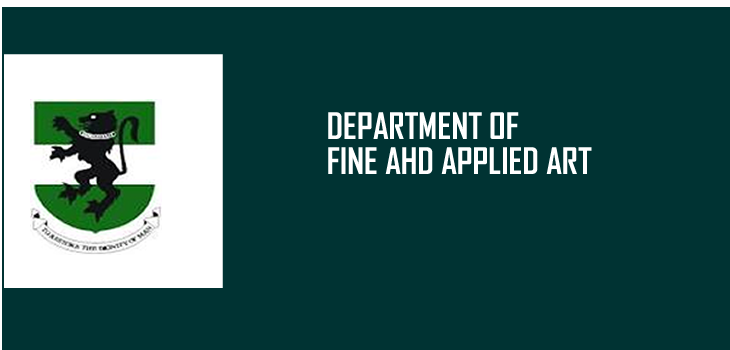BRIEF HISTORY OF THE DEPARTMENT
The Department was founded in 1961 with nearly all the art teachers being British or American. They instituted the Western academic approach of naturalism, which promoted pictorial observational realism. This brand of Western academic pedagogy was effectively terminated when the expatriate art teachers left because of the Nigerian Civil War (1967-1970). After the civil war, students and faculty members reassembled and resolved that the art programme of the Department had to be reconstructed to meet the demand of the new Nigerian society. From this period, a new culture of exploration and experimentation of the local environment in art teaching and learning dominated art activities of the school. Staff and students searched deeply into the nature and purpose of art and design in their communities as well as applying the proceeds of these intellectual and artistic endeavours into social and technological development. The content of the art programme made room for the incorporation of indigenous ideas, motifs, designs and styles into art learning and production. With this goal in mind, the Department developed and popularized Igbo patterns for body and wall painting known as Uli. Uli Art paved way for the emergence of a completely new visual vocabulary in the Department. Thus, the art programme moved away from Western style of naturalism to more abstract expressions and other stylistic changes that responded appropriately to the art experience in Nigeria.
Reaction against external academic art was challenged in favour of Nigerian forms. This created both contemporary and modern art, while accommodating new ideas. The effects of the new ideology were immense. Great efforts and enthusiasm were expanded to permeate this new concept into various sections of the Department, namely Sculpture, Painting, Ceramics, Textile and Visual Communication Designs.
The Department runs three types of programmes for the award of Bachelors degree in Fine and Applied Arts: Four-year, Three-year and Two-year standard programmes.
1st year of the three-year programme starts at 2nd year level. Thereafter, students follow the regular Four-Year programme at the 3rd year level.
Two-year standard programme follows the regular four-year programme at the 3rd year level.
PHILOSOPHY
The course of study in this Department has been devised to enable our youths re-discover themselves and dedicate their lives anew to the building of a strong nation. The discipline develops and exposes the students to multi-disciplinary dimensions of traditional and modern arts in order to produce the needed high level manpower in the country. The programme prepares students for self-employment and to occupy high level academic positions in the various levels of educational institutions, research institutes and the cultural sectors of the nation’s economy.
OBJECTIVES
The broad objectives of the programme are to:
-Produce well-trained and highly motivated students who are equipped to embark on a successful career  in Fine and Applied Arts.
-Promote excellence in studio practices in Ceramics, Visual Communication Design, Textile Design, Fashion Design, Painting and Sculpture. The Art History and Art Education programmes are well-balanced to provide the students with broad and balanced theoretical background so that they can function effectively in disseminating information as well as promoting Nigerian artistic and cultural heritage.
SCOPE
The programme leads to the award of Bachelor’s degree in Fine and Applied Arts in the following areas: Art Education, Art History, Ceramics, Fashion Design, Graphics, Painting, Sculpture, and Textile Design. For the standard four and three-year undergraduate programmes, the students are first introduced to the multi-disciplinary perspective of Fine and Applied Arts and, thereafter, exposed to the areas of specialization. Participation of students in the Industrial Work Experience Scheme (SIWES) is compulsory.
ENTRY REQUIREMENTS
In addition to the University entry requirements, applicants for admission through the UME must have credit passes in at least five subjects in the Senior Secondary School Certificate (SSCE) or its equivalent. The subjects should include English language and Fine/Applied Arts. Candidates who possess NABTEB/NTC must have five credit passes which must include English language, technical drawing, painting and decorating. For admission by direct entry, candidates must have one of the following:
(i) Credit level passes in OND (Ordinary National Diploma) in Fine and Applied Arts in
addition to UME requirements.
(ii) GCE Advanced level passes in three subjects which must include Fine Arts or Technical Drawing.
(iii) NCE Certificate with an average of B grade.
(iv) HND holders in Fine and Applied Arts or its equivalent in relevant areas that graduated
with an average of B grade may be admitted to the 300 level courses.


